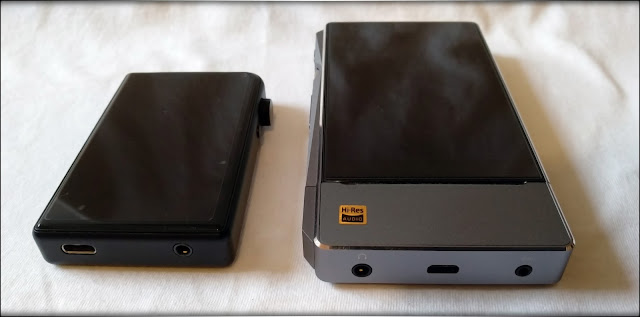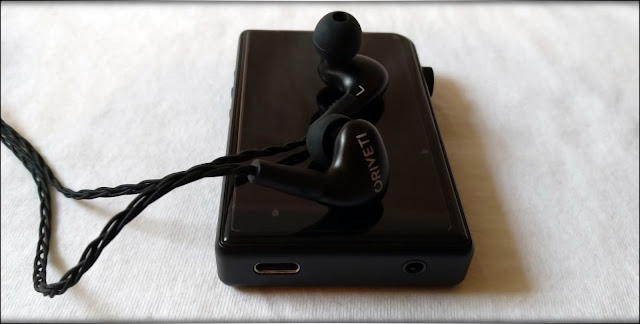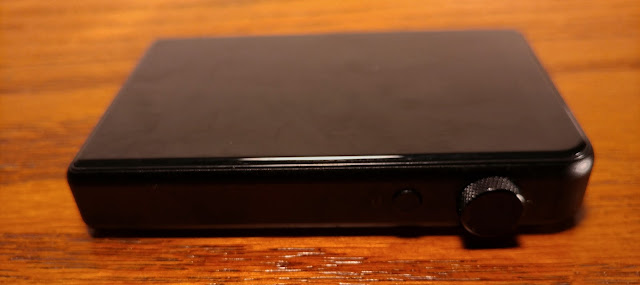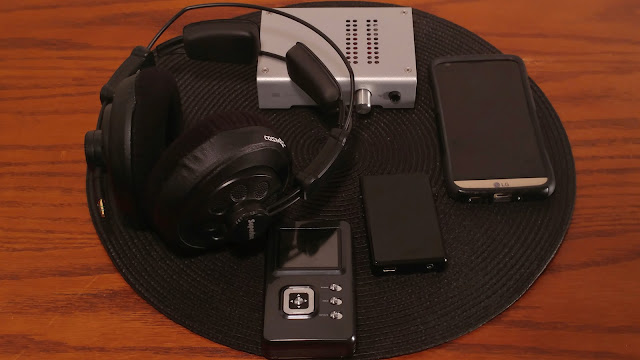I would like to thank Shanling for setting up the review tour for their 3 most commonly seen DAP models and for including me on the tour. I have owned 2 of the three in the past but never had them all in hand at the same time.
First let’s take a moment to look at the things these models all have in common before delving into the unique qualities of each.
Construction is solid with metal sides and high gloss glass backs each opposite a full-sized display. The screen has an outer black bezel that frames it all the way round but does a good job of disappearing when the player is powered off on the M2 and M3s. On the m1, the frame is more easily seen. Some of the buttons are in the same place on all three models. On the left side, forward and reverse are present although they are separated by a play/pause on the M2s and M3s that is not present on the M1. The M1 also has a return button on the left above the forward/reverse buttons. All three have scroll wheels on the right with the M2s and M3s having the return button immediately below the wheel. The M1 has the power button below the wheel while the M2s and M3s have the power button on the top at the righthand side. The bottom of all the units have the 3.5mm port and the USB-C port. On the M1 the SD Card slot is at the bottom while the SD slot on the M2s and M3s is on the left-hand side about ¾ of the way toward the bottom of the player.
M3s Top (Same as M2s)
Bottom View (Blue M1, Silver M2s, Red M3s)
Left Side View

Right Side View
Right Side View
A couple of things I will note that I would like to see updated on future models.
1.) All of the cases obscure the SD card slot so it is impossible to change cards without removing the case. With only having a single slot, it would be nice to at least make the slot accessible without having to go remove the case.
2.) On the M1, pushing the wheel inward works as the play/pause function. Giving the user the option to set the push-in on the toggle wheel to be the play/pause function on the M2s and M3s would make pocket use much more feasible as the leather case obscures the actual play/pause button to a degree that makes pocket use more difficult. This is not really bad on the m2s although there is no tactile way to be certain which button you are pressing without finding the others to reference its position. The problem is particularly pronounced on the M3s where the case covers the buttons and removes nearly all tactile reference to which button is which.
And now for something completely different....
While the three DAPs share a similar physical construction and the same UI, they are really not targeted to the same audiences and the question of which is best is going to depend largely on use case.
The littlest Shanling (for now):
The M1 is the smallest, lightest DAP in the Shanling stable and is aimed at the ipod Nano/shuffle market of gym dwellers, runners, and hikers/outdoor types. The size and weight of this unit is roughly ½ that of the larger two players. It comes with a strap for wearing the unit on an arm and the case doubles as a belt clip. The shortcomings of the M1 are intended trade-offs in order to achieve this size/weight ratio. With all portable players, battery life is a key issue and the smaller the unit, the larger the issue becomes. The M1 sports a 950mAh battery which when measured on my discharge tester was nearly exactly as specified. With such a small power reserve to work from, the M1 must be as efficient as possible and does a good job of divvying out power in a way to make the unit last nearly 8 hours on a charge if the display is only used sporadically and Bluetooth is disabled. Using Bluetooth does decrease the longevity of the battery to closer to 7 hours which is still very good. Output is good with low impedance/high sensitivity earphones, but as impedance rises or efficiency drops, the M1 becomes less and less useful. The specs list output as 35mW@32ohm which means that anything over 32ohm is probably going to feel underpowered when run off the M1.
Use cases for the M1
Put simply, if you are looking for a DAP you can slip in a pocket and forget, the M1 is for you. If you are a backpacker or hiker and are concerned about weight but want to take your music with you, the M1 and a pair of iems makes for a ¼ pound combo.
Fir use at the Gym, while running, or while out pursuing other outdoor activities, the M1 is an extremely compact package that makes it nearly perfect.
If you intend to use Bluetooth headphones, the M1 also makes a great choice since it’s size and battery life make it fantastic for dropping in a pocket and heading out for the day.
For non-head-fi types, the M1 makes a good first dap as the limitations (lack of full DSD support, and limited output power) are not likely to come into play with most consumer level headphones or common mp3/Aac files.
If none of these options are your use-case, read on.
The other end of the Rainbow – The M3s.
If the M1 is a the cut all corners to save weight and cut size gym use model, the M3s is the no-holds barred audiophile model. Sporting dual DAC chips and OPamps, 32/384 resolution, DSD 256 support with an 11.2mhz clock for DSD, balanced output, and specs to be proud of for both distortion and SNR, the only things the M3s seems to have in common with the M0 are a similar set of physical controls, and a familiar UI. About the only feature distinctly lacking on the M3s is support for Dual micro-SD cards which is commonly found in players at this price point. (Even Shanling’s flagship M5 does not have dual card support and actually says it is limited to 128gb card size although personal experience suggests otherwise.)
The M3s aims squarely at the likes of the Opus #1s, the Fiio X7ii, the Cayin N5ii, Cowon Plenue P, the pioneer/Onkyo DAP, and the AK 70. To say the market is crowded at this price point is an understatement, so how does one compete? For some (Opus) the answer is to focus on one aspect and make it the best it can be. For most others, it is to pack absolutely as many features as possible into the box and hope that one of those features is the thing that tips the scale in their favor. The M3s takes the later road and packs, Bi-directional Bluetooth with all the bells and whistles (Apt-X), HibyLink so the player can be remotely controlled, USB DAC mode for use connected to a computer or phone, digital filters in addition to a customizable EQ, along with the previously mentioned dual mono signal paths and both single ended and balanced outputs.
In order to run all this circuitry, the M3s steps up to a 2600mAh battery which measures 2430mAh on my discharge test. This is enough to provide a full day’s use (12 hours on single ended, nearly 10 hours using Bluetooth, and 7.5 hours using balanced output). By all accounts, this is among the best in class as it outlasted the Plenue, Opus, and Cayin N5 on single ended playback and bettered the Opus and AK on balanced. The only players that bettered the battery life of the M3s in my tests were those with a single DAC chip and it certainly seems reasonable that when you have ½ the circuitry to power, you should be able to make the battery last longer.
The sound of the m3s is very good but shows some of the natural leanings of the DAC chip used. In recent years AK’s premium line has been called the “Velvet Sound” series and I think that is a good description of it. The AK4490 is very musical at the expense of masking some of the micro-detail. The M3s has good bass extension with slightly forward bass that extends into the mid-bass range, mids are thinner than the bass and highs are again slightly forward. Treble extension, while good, is not quite as well extended or controlled as the Opus #1s. The good news is the M3s is capable of excellent reproduction when fed good source material and still be forgiving of poor sources. Considering the fact that many will pair the M3s with streaming audio sources (Tidal, Spotify) this makes a good compromise. The downside of the M3s tuning is, smooth musical rendering can hide detail which is most evident in the already slightly thin mids.
The next thing to look at with the M3s is which earphones to pair it with. The Output power of the M3s is nearly 4x that of the M1 in singled ended mode (35mW vs 130mW) and nearly double that again when using balanced (230mW) (All of these ratings are at 32ohm). I had no trouble driving headphones up to 150ohm using the single ended output and was able to drive some 600ohm Beyer’s using the balanced out. At 600ohm, you are not going to get very much volume out of the M3s to be sure, but not many people use 600ohm headphones while on the go anyway. When paired with either iems or portable headphones, the m3s has no trouble getting volumes to realistic listening levels with plenty of headroom to really crank the volume for those who want to rock out.
Use Cases for the M3s:
1.) Looking for portable DAP for DSD (up to and including DSD256) or 32/384 playback, this is one of the few that has the specs to really handle it while still retaining enough output power to run larger headphones.
2.) If you are looking for a dap that offers the ability to tether your phone and stream music from your favorite services, the M3s offers both Bluetooth and wired options.
3.) If you want to be able to use your DAP as a transport for an external DAC (either Bluetooth or Line out) or if you want to do the opposite and use the M3s as a DAC for you USB capable source, you have both options.
4.) If you are looking for a DAP with balanced output to offer additional power to higher impedance or lower sensitivity earphones that need that bit of extra push the M3s offers balanced output with enough power to run hungry cans and enough battery to last a full workday.
Middle Ground – the M2s
Some people will have read to this point and realized that at different times of day, they fit into both the M1 and the M3s use case. While you could always purchase both if your budget will allow, there is another option that while a compromise, gives you most of the features of both the m1 and the M3s in a single device.
The M2s is exactly in between the M1 and M3s in dimensions and very close to the midway point in weight although it leans more toward the m3s in feature set and battery capacity. The M2s uses the same chip as the M3s but instead of using one per channel, the M2s uses a single 4490 to handle both channels thus saving 50% of the circuitry. This allows for a 1800mAh battery while maintaining an 8-hour battery life. The M2s shares the ability to use it as a DAC with your USB source, or as a source for your USB DAC. It will also tether to a phone via Bluetooth and allow the use of your favorite streaming sources. Output power is the same as the Single-ended output of the m3s. The M2s does not have the balanced output of its bigger brother but for many that will be a non-event as most headphones come wired for single-ended. The M2s has more than enough output power for most in-ears and portable headphones up to 150ohm. Above 150ohm, the output begins to drop in volume and while still usable, it will be limited. Above 300ohms, the m2s begins to struggle to produce enough volume to be listenable. A lot will depend on how efficient the headphone or earphone used is, but it is worth noting that for high impedance/low sensitivity cans, one should try the m2s first before assuming it will have adequate power to run your cans at a comfortable listening level.
Use Cases for the M2:
1.) If you have a need for a DAP with good sound quality for use with Single Ended earphones.
2.) If you want to stream media from your phone and let the DAP do the work of decoding and save your phones battery.
3.) If you want a DAP you can use as a source with USB DACs or if you want to use your DAP as the USB DAC with another USB source.
Conclusions:
I had mixed emotions about the M2s as this was the one of the three players I hadn’t owned previously. My thinking going into this review was: I questioned whether the $79 price difference between the M2s and M3s was enough to be worth losing the 2nd DAC and the balanced output. After using both players for 10 days, I can say conclusively that I made the right decision for me by purchasing the M3s. On the other hand, if you have a limited budget, the M2s makes a very good all-around player with a lot of capability and premium build quality. The $200 DAP market has gotten very competitive and while I can’t say the m2s is the only player one should consider, I can certainly say it deserves a spot amongst the top 3 I have had the opportunity to try at or near the $200 price point.
I could find a reason to buy all three of the Shanling Players and actually have purchased 2 of the 3 already. The M1 is about perfect for a pocket player when combined with any easy to drive IEM. For a combined price of sub-$200 for the M1, the case and something like the KZ-Zsr it would make a good gift idea for those new to audio. This combination may well end up in a few stockings come this winter. For my office DAP, I could be happy with either of the larger two depending on budget constraints. At the top end, the M3s is competitive with the sound quality of the likes of the Opus #1s, the AK70, and the Cowon Plenue which puts it in very good company.
While the three players may not be interchangeable and some fit specific uses better than others, it is hard to imagine a use case for which one of the three is not a top-flight competitor. Knowing that even as I type this Shanling has introduced and even smaller and touch screen M0, I can only surmise that the next generation of DAPs from Shanling will likely all incorporate the changes found in the M0 in the next generation of their higher-end products and continue to improve an already very solid line. If you haven’t yet, you should check out Shanling, chances are pretty good they build something that will make you smile.
CHIPS and DIP (Sockets that is). (Notes an DAC Families)
I spent some time AB testing the M3s vs some other DAPs in the same general price range. It seems that three chip families define the market at this price point; The Sabre series (9018/9023/9028), the Cirrus Logic (4398 and 43198), and the AK (4490,4490EQ,4495). All three families are very capable and while I think that implementation is far more important in the overall sound produced by the DAP than which chip is used, chip families due tend to have a house sound or tuning that tends to be visible in most of the products sporting the chip. I want to admit right up front, input quality, input processing, clock quality, and analog stages have a lot to do with sound and implementation is more critical than which chip is used in creating a quality product. Those other components may either enhance or mask the natural tendencies of the DAC making it harder to pick out which family is in use but with more samples of products with each chip, certain qualities do begin to show through.
AK (4490)– Good bass extension but slightly forward bass that extends into the mid-bass range, thinner mids, followed by slightly forward highs. Treble extension, while good, is not quite as well extended or controlled as the Sabre line. AK calls the line the Velvet Sound and I think this is a good description as when I think of velvet, I think smooth. The AKM series in general produces a very musical signature and is more forgiving of source material than either of the other families. The downside of the AKM tuning is, smooth musical rendering can hide detail and does especially when it is combined with the slightly thinned mids. For me, as a devote of blues-rock, guitar detail is all important and the AKM can sometimes mask it.
Sabre (9023) – Very accurate and clinical at the expense of being the most digital sounding of the three. If AK went for the “Velvet” signature, Sabre went with “technical”. Where AK went with natural, almost tube sounding filters, the Sabre series went for absolute precision sometimes at the expense of musicality. The Sabre series tends to have the brightest sound of the three families partially because it also has the best treble extension of the three (at times by a pronounced margin). The lows and mids of the Sabre series tend to be closer to neutral than the AKM series and slightly thinner.
Cirrus Logic (43198)– The CS chips tend to be a little closer to the Sabre than the AK in that they are slightly bass light with neutral mids and well extended highs. They are a bit thicker and fuller than the Sabre while still maintaining a clean sound and more detail than present in the AK chip. The CS provides a balance between the other two chips that offers some of the technical micro-detail of the Sabre while maintaining some of the musicality and natural tonality of the AK.
Again, these are the ramblings of an old fool so your mileage may vary.















































































































































































































